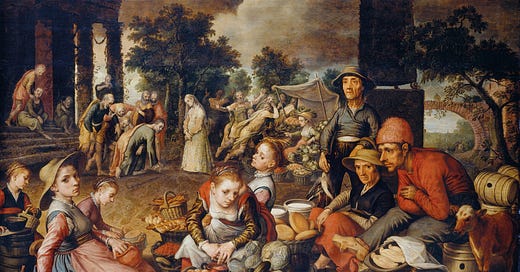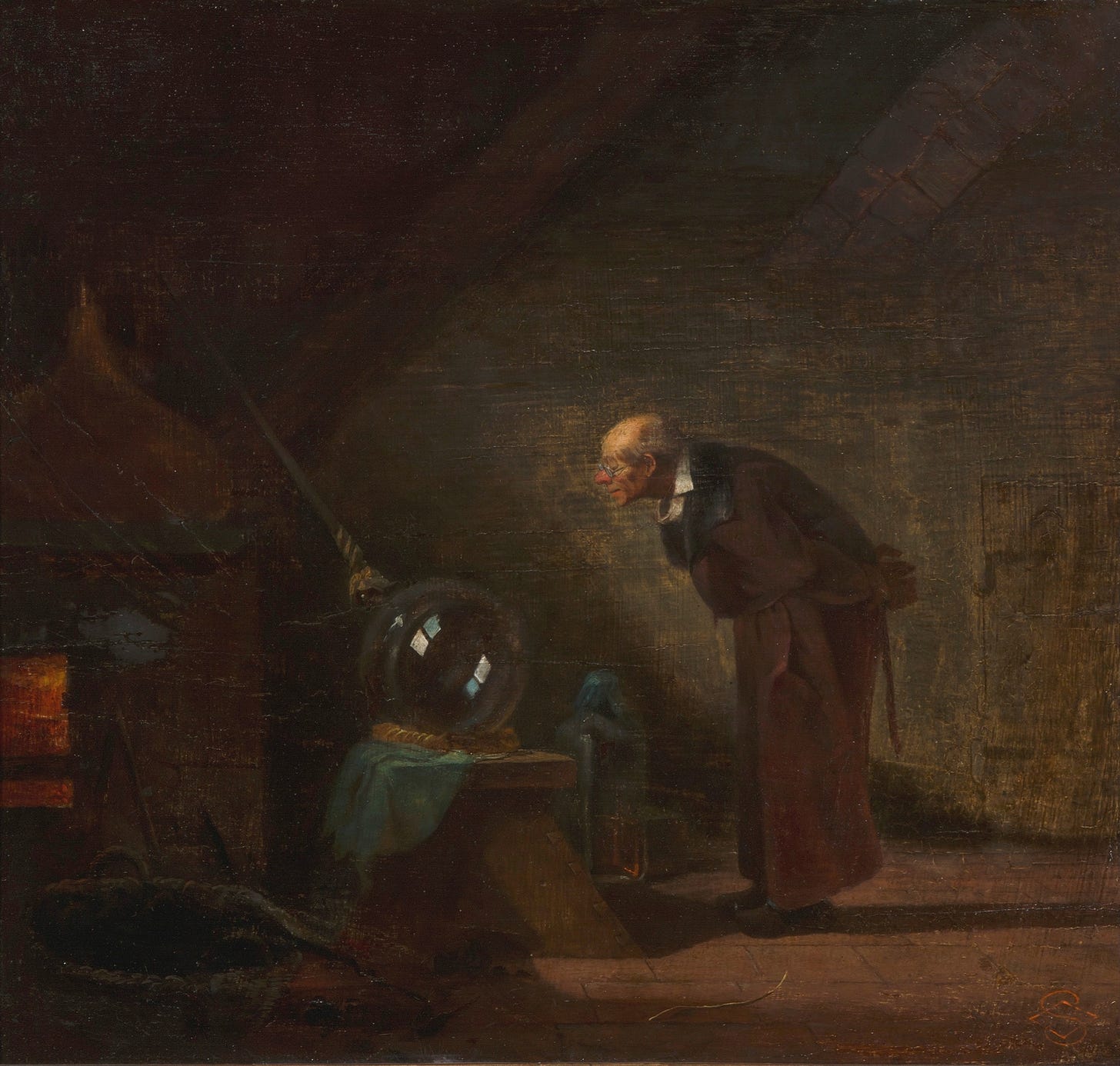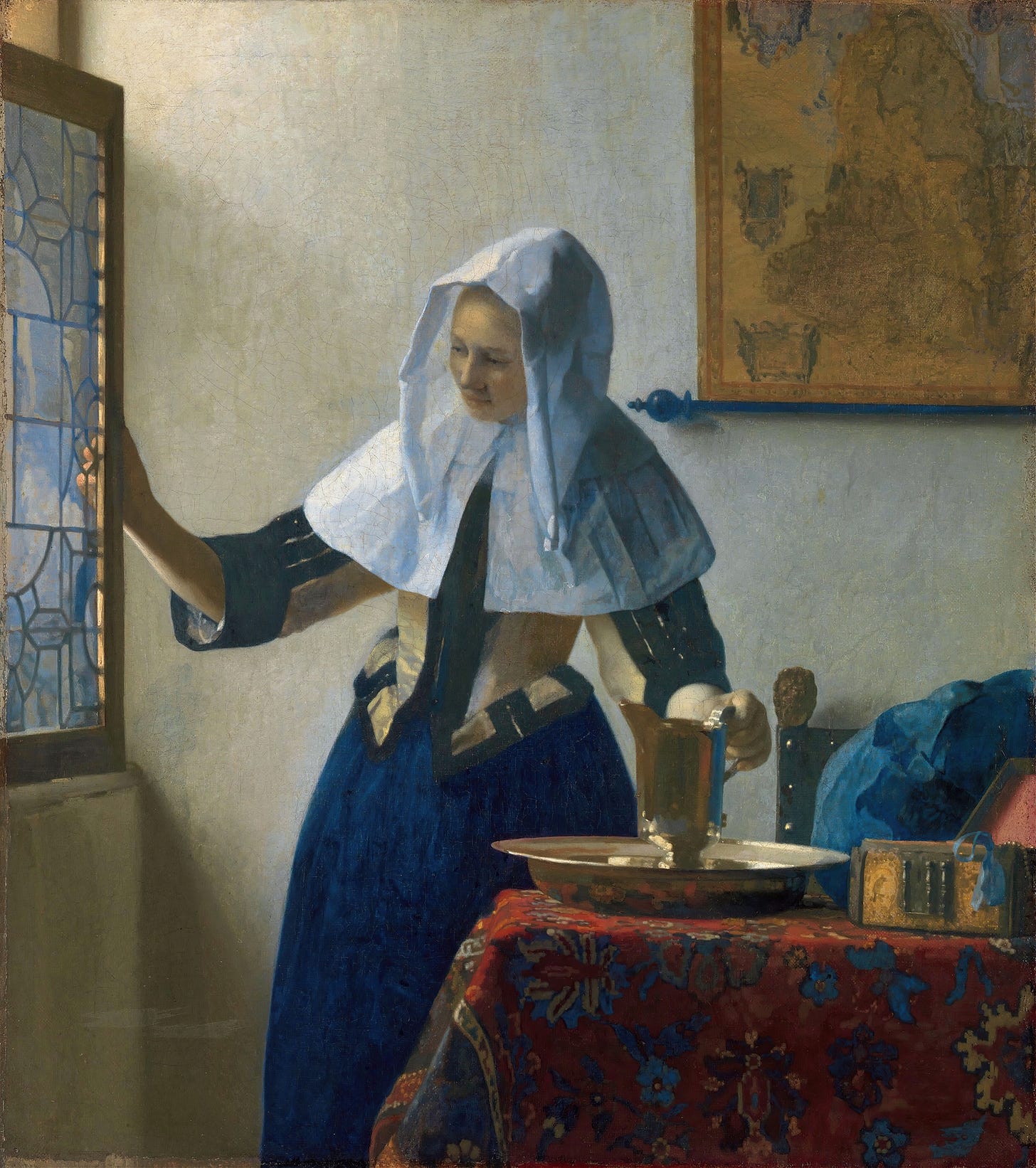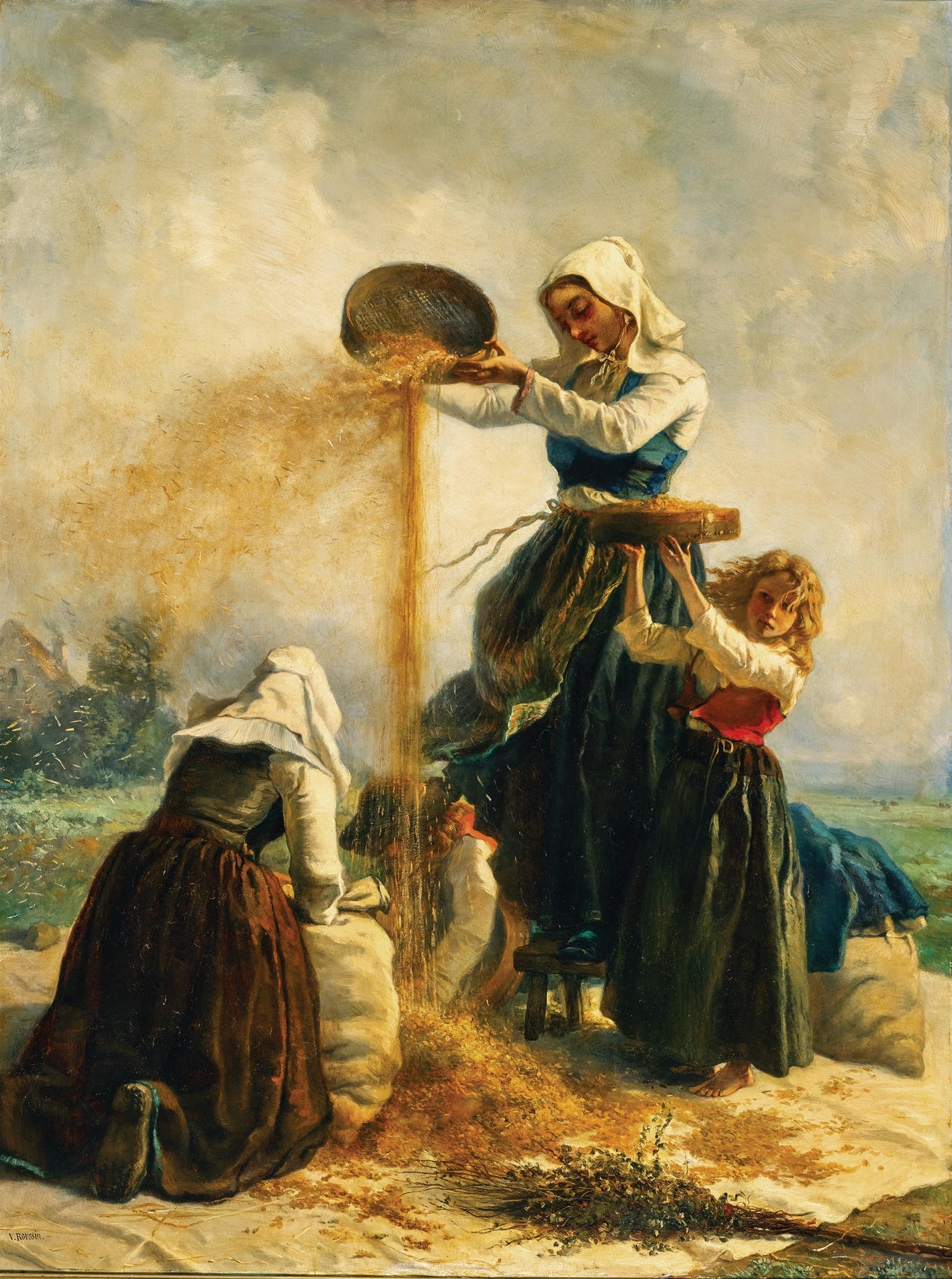“Ye awe me yet for the wool, Londoner!” The local wool merchant's voice cuts through the noisy York marketplace on a crisp, 13th-century April morning. “My wife sent you the full lade this last month when scho dealt with our store.”
The London cloth merchant manages to make out, with some difficulty, what the Yorkshireman is saying. He replies, “I… owe you? I owe you not! Ye say, your good wife sent the full… load? Hoo did no such thing. The load was half what we corded on. Therefore the fee is eke half.”
corded = agreed
eke = also
“Scho would never guile a chapman so! Scho is a wife too honest for such southern craftiness.”
guile = cheat
chapman = merchant, customer
“Speak seemingly, man! What is this scho ye say? Hoo is the meet word for a woman.”
seemingly = properly
meet = appropriate
The Yorkshireman’s face reddens. "I speak as my fathers spaken, no in your quaint southern tongue! The accord stands, as scho wrate it."
quaint = strange
accord = agreement
A small crowd has gathered around the men, some smirking at the outlandish language of the Londoner, others keenly interested in the outcome of the business dispute.
A nearby scrivener, who makes his living drawing up contracts for the illiterate, watches with professional interest. As a man from the East Midlands, he’s inclined to say sche rather than scho or hoo — but he was a professional, and would always accurately record what the merchants said, that is, if they come to an agreement in the first place.
To speakers of Modern English, both the hoo and scho of this Middle English dialogue are unfamiliar. Instead, it’s the East Midland scrivener’s sche — or, in modern spelling, she — that we recognize as our own feminine pronoun.
Etymologically speaking, however, it’s the word she that is the mysterious one: hoo and scho can be easily traced to their Old English ancestors.
Hee, hoo, sche, scho…?
In fact, all of the other personal pronouns we use today — that is, I, you, he, it, we, they — can be traced back to their Old English (AD 450–1100) ancestors (or in the case of they, to Old Norse). But not she.
When we look at the Old English form corresponding to Modern English she, we see no obvious connection. In Old English, the meaning ‘she’ was expressed by hēo (pronounced approximately like “heyoh”). Neither the spelling nor the pronunciation of hēo shows any resemblance to our modern form she.
If hēo had continued in use, the most likely way we’d write it today would be hee or he. And it would sound identical to the masculine pronoun he. We’ll return to this point shortly.
At least, becoming an ee sound is typically what happened to the Old English sound ēo in Modern English. So Old English bēo became Modern English bee, glēo became glee, and trēo became tree. And, in fact, we do see forms like hee (spelled variously) in southern dialects of Middle English (1100–1500).
But not all ēo words in Old English turned into Modern English words with ee. A few Old English ēo words gave rise to Modern English words with oo: the best example of this is Old English ċēosan (pronounced like “cheyo-zan”), which became Modern English choose rather than cheese. (Although, interestingly, the word cheese, meaning choose, does show up in texts until around 1500!)
If hēo followed the ċēosan-to-choose pattern into later centuries, it would become something that our 13th-century Londoner might well recognize: hoo. And, in fact, it does show up in Modern English — sort of — it’s just that it’s not standard Modern English. That hoo appears in rural dialects spoken in parts of Lancashire, southwestern Yorkshire, and other places in the northwest Midlands.
What’s clear, however, is that hēo didn’t take just one path into later forms of English. By the 12th century, a bewildering variety of forms had emerged across England's dialects: sche, scho, cho, she, heo, ho, and many other variations were all used for she.
Over most of the Middle English period (1100–1500), English was not the language of government and high culture — that was French. As a result, English was never subject to the pressures of standardization that come along with being the language used by a government. So the Middle English period is the period of most obvious diversity among dialects in the history of the English language.
Even with this variation and lack of standardization, the explosion of different words all meaning she is particularly striking. And we still haven’t answered the question of where the word she actually comes from!
The traditional explanation holds that she derived not from hēo, the true Old English equivalent of she, but from another word sēo — which meant ‘the’ or ‘that’, alongside a feminine noun. This would make English's development parallel to what happened much earlier in other Germanic languages, where the feminine pronouns — like Gothic si, and Old High German siu — ultimately derived from demonstrative forms meaning ‘that (feminine) one.’
However, this theory faces significant challenges — most notably that sēo had largely disappeared from usage before the new forms of she emerged, creating a chronological gap that is difficult to bridge. So, if not from sēo, where does she come from?
The Shetland theory
One explanation is what philologist A. H. Smith called the “Shetland Theory.” Smith suggests that she wasn’t a different word from hēo at all — it actually developed from the original hēo through a series of sound changes.
This change would have happened something like this: the Old English hēo, where the core of the sound was on the ē rather than the o (like “heyoh”), gradually shifted to a pronunciation like “hyo,” where the core of the sound was on the o rather than the e.
Then the “hy” sound (similar to the ‘h’ in modern human) changed to a “sh” sound. This kind of sound change isn't unusual — we can see similar patterns in certain place names, especially in Scotland and the north of England. Perhaps it’s not a coincidence that these were the same areas under the most Scandinavian influence.
The Shetland Islands, for instance, were originally called “Hjaltland” in Old Norse, where the ‘j’ was pronounced like English ‘y.’ So a pronunciation like “hyaltland” gave way to something like “shaltland” and, eventually, Shetland. The ‘hy’ sound in the original name changed to ‘sh’ over time — the same change we see in she.
To see why, elongate the ‘hy’ sound in hue — then make a ‘sh’ sound, as in shoe. For most speakers of English, these two sounds will be fairly similar. Without the context of the word around it, it may even be hard to tell the difference between the two.
At any rate, if this sound change is of northern origin, it explains why forms like scho and she first appear in texts from northern and central England, before gradually spreading southward, eventually replacing the southern hee/hoo forms by the 14th century.
But we’ve so far only explained the origin of scho — even if the Shetland theory is correct, it doesn’t explain the form she with an e.
In order to get a form like she, we need to combine the beginning of the northern form scho with the end of the southern form hee. The result is the East Midlands form sche, or, in modern spelling, she. Or perhaps the e in she comes from the influence of the masculine pronoun he.
Either way, something funny must have happened to get to the form she! We just don’t know exactly what it was.
Pronouns under pressure
What we do know is that different regions of England used different forms of the pronoun: scho in the north, sche in the central eastern regions, and hee/hoo in the south. Remarkably, some of these dialect differences survive even today — in parts of Yorkshire, you can still hear shoo (a descendant of the old scho), while in Lancashire and nearby areas, some rural dialects preserve the Old Southern form hoo.
The success of these new sh-forms was probably not an accident. The early period in Middle English was one of significant grammatical upheaval, which saw the simplification of word endings across the language.
Amid all this change, the original distinction between masculine hē and feminine hēo had become erased, with both words sounding like hee — and, although it’s not necessary for a language to distinguish masculine and feminine pronouns (ask Mandarin, which uses tā for everyone), there may have been some pressure to keep the two separate.
The distinctive sh-forms provided a welcome clarity, creating an unmistakable contrast between masculine he and feminine she. This pressure likely accelerated the adoption of the new forms across dialects. By the time of Chaucer in the late 14th century, she had become the dominant form in most written English, though dialectal variants persisted (and, as we saw above, continue in some regional dialects today). What began as a northern peculiarity had become a standard feature of the language.
Today, she ranks among the most common words in English, appearing over 3000 times in every million words we write or speak. But it’s an outlier — not just in the history of English, but among the relatives of the English language as well.
English stands alone among Germanic languages in having a feminine pronoun that begins with sh: German uses sie, Dutch has zij, both forms related to sēo. Scandinavian languages use forms beginning with h, such as hun and hon, which are related (indirectly, at least) to the Old English hēo.
The spread of she reflects a broader pattern in language change, one we often see in the more functional, nuts-and-bolts parts of the language — things like pronouns, and grammatical endings on nouns and verbs, as opposed to words describing things out in the world. The rise of she shows us how forms often triumph when they maintain distinctions that the language “cares about.” In other words, language change isn’t always a blind force willing to run roughshod over old grammatical patterns — although it certainly can be.
Language change typically happens unconsciously over generations, but when we look at it from a distance, it sometimes fools us into thinking the language is making choices. And when I say that the language “cares about“ grammatical distinctions, I’m flirting with being fooled myself. But if we understand this idea that languages make choices, metaphorically, we can see the success of she as something like the result of one of these choices — the choice to preserve what was seen as a crucial grammatical distinction.
Whatever else it may be, the story of she is a glimpse at just how much mystery lies behind even the most commonplace things we say. Pronouns like she may appear fixed and eternal in our language, but behind even these most common words lie centuries of change.









> Language change typically happens unconsciously over generations, but when we look at it from a distance, it sometimes fools us into thinking the language is making choices. And when I say that the language “cares about“ grammatical distinctions, I’m flirting with being fooled myself. But if we understand this idea that languages make choices, metaphorically, we can see the success of she as something like the result of one of these choices — the choice to preserve what was seen as a crucial grammatical distinction.
You can see a similar process today with English's attempt to generate a new second person plural pronoun.
In Hebrew, the thrird-person singular pronouns, written in our characters are:
Hoo (masc.) and Hee (fem.)
Since I know that Semitic languages are not even Indo-European, I realize that any such connection would be a stretch. Nevertheless, I just wanted to put it out there.